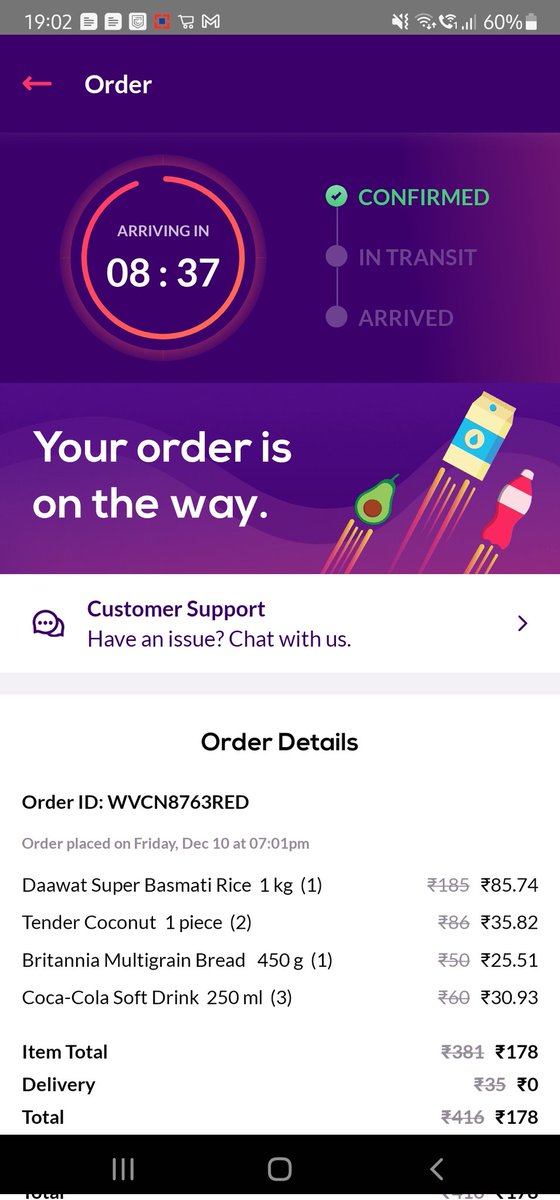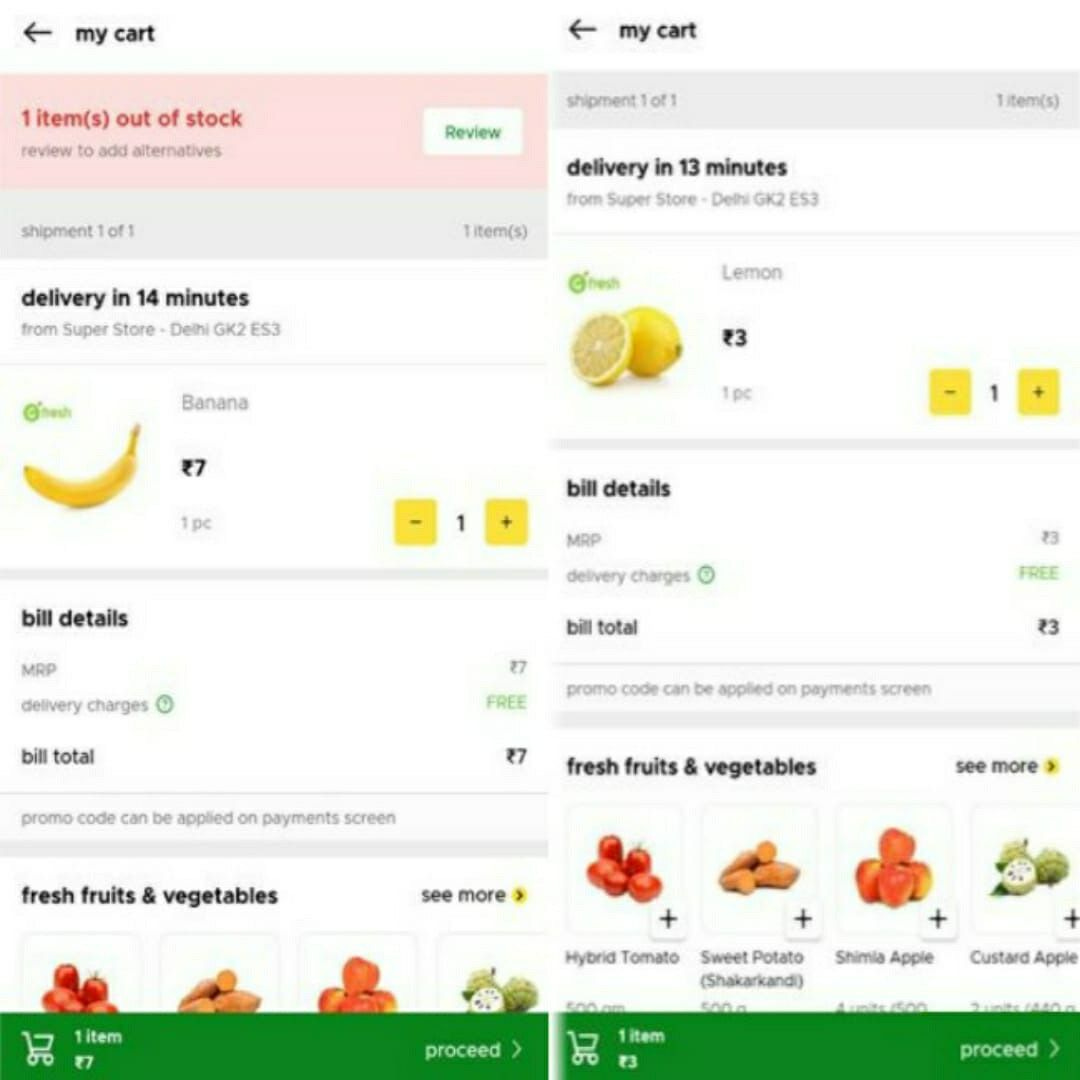What justifies ultrafast delivery?
Ten-minute deliveries are birthing an impatience economy and changing consumer behaviour. But what do businesses get out of it?
Good Morning! A big hello to readers who signed up this week. This is The Intersection, The Signal’s weekend edition. Today, we look at the promise of the impatience economy, and how companies are looking to create that need. Also in today’s edition: the best long reads curated for you. Happy weekend reading.

When Albinder Dhindsa gazes at his company dashboard, he sees an average of 200,000 transactions every day—or so he claims.
That figure is all the CEO needs to justify why his ultrafast delivery service, Blinkit (formerly Grofers), exists.
“You’re thinking too logically by trying to make sense of a paradigm shift. I can’t explain why the need exists either,” Dhindsa tells The Intersection over telephone, when asked who needs 10-minute deliveries. “I just know that if people want this today, they’ll want it in the future too.”
Blinkit is one in a crop of four (Zepto, Dunzo, and Swiggy’s Instamart) putting the on-demand economy on steroids. Their promise to deliver anything in 10-20 minutes is upending your neighbourhood with dark stores, frenzied delivery personnel, and—in the case of Blinkit—people whose sole job is to load your cart in under 2.5 minutes. With Blinkit, order assembly happens in real time as you’re adding items to your in-app cart. Because of this, smaller orders can be readied in as few as 60 seconds.
Dhindsa may be disinclined to understand why customers would want such a degree of hustling; he insists, after all, that the latent, collective need for ultrafast hyperconvenience is organic, borne of evolving expectations in a world bereft of time. That belief is why Zomato gave Blinkit a $100 million shot in the arm, why Swiggy is investing $700 million in Instamart, and why Zepto raised $60 million just six months after launching its app.
The concept of express delivery isn’t new; customers establish relationships with local kiranas and fresh-produce vendors, the nature of which would determine whether they’d deliver your order in 15 minutes or an hour—for free.
That system is still thriving but the new bunch of tech-driven, efficiency-focused businesses are uprooting the relationship-based model and replacing it with a transactional one. They are fundamentally altering the nature of on-demand-everything from addressing unavailability to addressing expectations. The dollar stacks at the disposal of each of these players are being freely burnt to recondition the consumer psyche and fabricate an impatience economy.
This brings us to two questions. What is the use case of ultrafast delivery beyond emergency or emergency-lite situations? And are the returns worth the investment in shaping consumer psyche?
It’s all about behaviour, baby
“The impatience is definitely manufactured. Ten, 15, and 20-minute promises are artificial anchors created to exploit present bias.”
That’s Anirudh Tagat. He’s an economist with Monk Prayogshala, a research institution specialising in psychological and economic academic research.
The theory of present bias is a mainstay in the field of behavioural economics. It states that humans (and even animals) defer larger, long-term rewards in favour of smaller, immediate rewards. We do so because the present is a certainty, while the future is a probability. Present bias explains why we splurge on something despite wanting to save for the future, or why we give in to a craving despite wanting to eat healthy in the long term. This time-inconsistent behaviour predisposes us to make impromptu choices rather than defer them; after all, we can only estimate the value of a future payoff.
Consumer-facing businesses deploy immediate rewards such as discounts, bundles, hyperconvenience, and express delivery to exploit our present bias. These are the artificial anchors Tagat was referring to.
The obvious use cases for ultrafast delivery are extremely limited—wanting cigarettes or contraceptives, missing an ingredient while cooking, or needing more tonic water for the drinks served at your house party—but you’ll still opt for the service even if you don’t need it.
What lengths are we willing to go to for micro-moment gains, though? Ultrafast delivery companies are exploiting labour, eroding communities, and conditioning us to interact less with people and places. The transactional nature of our buying habits has now seeped into our relationships with the very cities we live in.
This brings us to ask: what long-term rewards are these platforms reaping from such disruption?
To plan or not to plan? That is the question
Instant gratification has takers, especially among a niche, top-of-funnel audience that wouldn’t mind hyperconvenience given its high frequency of orders. But as emphasised above, there’s also a behavioural nudge by ultrafast delivery platforms to fundamentally alter how you shop for groceries. They want to take planning out of the equation, one ten-minute delivery at a time.
In most households, grocery shopping is a scheduled activity save for the occasional ‘top-up’, where you unexpectedly run out of something and need it in an instant. In venture capital speak, 30-minute deliveries are classified as unplanned. It is this unplanned, ‘top up’ market that ultrafast delivery platforms are gunning for.

| |||
| Replying to@gokulns | |||
Mom was cooking something but ran out of tomatoes. She needed it in urgently so I ordered from zepto. | |||
Dec 12, 2021 | |||
 | |||
1 Likes 0 Retweets 0 Replies |
“The promise of immediate gratification leads to System 1 thinking, where you react more quickly or intuitively. System 2 thinking requires planning and cognition, which we’re willing to suspend as we experience more cognitive load,” says Hansika Kapoor, who leads the department of psychology at Monk Prayogshala.
There’s yet another market that the likes of Blinkit are eyeing, and those are customers with planned daily baskets (eggs, milk, bread, etc). In the crosshairs are subscription-based micro-delivery apps such as Reliance-owned Milkbasket and SuprDaily (now part of Swiggy).
The objective is simple: get people to stop scheduling daily baskets altogether.
“I see this as a ‘no need to stock up your fridge’ disruption. What you were doing until now when you wanted a quick bite was to look in the fridge,” says a Bengaluru-based venture capitalist who follows the space closely. “Now you can just open the Zepto app and order, and it will reach you in a few minutes.”

| |||
This is insane ! Zepto showing timer with seconds. The grocery delivery war is 🔥 | |||
 | |||
Dec 10, 2021 | |||
 | |||
5 Likes 1 Retweets 1 Replies |
But at what cost?
Quick commerce remains a primarily urban phenomenon concentrated in Bengaluru, Delhi-NCR, some parts of Mumbai, and other Tier-I cities with gated communities. But investing heavily in dark stores within a two-three kilometre radius of these hotspots can only go so far. In large, gated communities and apartment complexes quick service companies will be competing with in-complex kiranas and even malls. The Hiranandani Estate in Thane, for instance. Unless, of course, they rely on discounting and eventually drive the mom-and-pop stores out of business, making customers dependent.
Add to this the cost of operations, monthly rent (estimated to be anywhere between Rs 2 lakh and Rs 40 lakh depending on area and city) of dark stores, cost of carrying inventory, human costs and transport. Human costs comprise the manpower required to pack and load carts, and delivery partners. In a business with wafer thin or negative margins, even petrol costs at Rs 60 a litre and Rs 100 a litre can make all the difference. These costs are currently bankrolled by venture capitalists.
Perhaps this is why Blinkit does not enforce a minimum order value for free delivery. As it stands today, you can order a single banana or lemon without paying a delivery fee, except during ‘surge hours’.

Albinder Dhindsa admits that there’s “abuse” of the zero delivery fee system, and that Blinkit is “learning and evolving” with respect to whether free delivery should be a perpetual feature or not.
“But the 3,500-4,000 products we have across our many dark stores ensure an average ticket size of Rs 700,” Dhindsa adds. He also underlines that Blinkit, unlike other ultrafast delivery platforms, isn’t limited to groceries and other staples; depending on how equipped the dark store is in your location, you can even buy home appliances, winter wear, and bed linen.
“Express delivery platforms would need to significantly alter the behaviour of the average grocery-buying Indian before achieving scale on ground. Which is a very hard problem to solve,” says Raj Subramaniam, in a telephonic conversation with The Intersection. Subramaniam is the founder-CEO of Paisool, a retail management company.
Of the four companies, Blinkit has the largest number of dark stores—over 200 across 12 cities. The average of 200,000 daily orders that Dhindsa claims works out to an average of about 17,000 orders per city. That is not much considering the populations and that the company has been one of the early movers in the grocery delivery business. As Grofers, it first tried asset-light hyperlocal delivery, then shifted to an inventory-heavy model and has now junked all of it for flash deliveries.
“If you look closely, the solution is already present minus the tech layer. Kirana stores offer the same 10-15 minute convenience if you have a good relationship with them,” says Subramaniam.
The newest entrant Zepto cut its teeth as a quick-service company from the word go. It has since fine-tuned its technology and processes; perhaps to the point that it may be hitting the limits of eking out time efficiencies. It’s dark stores reportedly take less than a minute to dispatch an order, from the point of receiving to handing it to a courier.
The only way to shave off more seconds and operating costs would probably be to deploy robots for packing and drones for delivery.
Where does this end?
Each of the companies slugging it out in the market has come to super-fast deliveries with its own learnings and expertise. Grofers has learnt from its failed hyperlocal model. It now also has Zomato’s expertise as a fast-delivery business to lean on. Instamart leverages Swiggy’s prowess in delivery and operating cloud kitchens. Zepto has technology and process expertise. BigBasket, which is planning to take the plunge into express delivery, is entrenched in the entire supply chain from farm gate to storefront.
Despite the different strengths, the ultrafast delivery business is a moatless (except having limitless capital) one, according to industry experts.
“The model isn’t profitable. It can’t be, unless dark stores operate on a B2B rather than B2C model, or unless the FMCG brands on these apps shoulder marketing costs,” says Anirudh Damani, managing partner at Artha Venture Fund. “The latter won’t happen, because no delivery platform shares data about geographical hotspots, repeat orders, and consumer buying behaviour in general,” Damani, who was an investor in SuprDaily before it exited to Swiggy, says.
Experts also say that there is also an attempt at NPS jacking or pumping up the net promoter score, a metric which uses social media mentions instead of surveys as proxy for customer acceptance. In this case, that would involve tweets from venture capitalists, founders, or startup enthusiasts helping these delivery brands go viral and create a network effect.
For now, ultrafast delivery is a hammer in search of a nail.
ICYMI

Ivy Scam: Journalist Nidhi Razdan fell for a Harvard recruitment scam between 2020-21. It turns out that she wasn’t the only one targeted. An investigation found that Razdan was among several women who were baited by fraudsters with realistic-looking email addresses, phone calls and stamped letters. The real motive behind this scam remains unresolved.
Trailblazer Feminist: Growing up in a segregated America, bell hooks wanted to break away and create art from a distinctly Black perspective. Her work revolved around creating awareness about the socio-political system obstructing Black women’s self-esteem and how tiny acts of revolution make a big difference. This piece explores the legacy of the feminist author who died this week.
Fast Fashion: If you’ve noticed a celebrity wearing an interesting outfit and wanted a similar-looking but cheaper option, Shein is the site. A Rest of World investigation showed that the Chinese fast fashion platform is taking over sales globally by making low-cost styles in bulk for export by copying popular designs and setting unachievable tight deadlines for production.
Propaganda King: Just two weeks after reports of Chinese tennis star Peng Shuai’s disappearance amidst sexual assault allegations, Global Times’ editor Hu Xijin posted a picture of her public appearances. As allegations of ‘staged’ images poured in, Hu shot back and trolled every critic, dutifully serving his master propagandist role. In fact, he could well be the only man with freedom of speech in mainland China.
Cult Supremacy: Black Axe, a 40-year-old Nigerian organisation linked to violent crime still operates billion-dollar financial scams. Critics are brutally murdered and law enforcement agencies haven’t been able to make any difference. A two-year investigation by the BBC has discovered how Black Axe has slowly turned from a cult to a gang and now transformed into an international mafia network.
Too far down: Taking a dangerous detour from suicide prevention websites, an American duo set up a platform that offered tips on self-harm. This interactive story by The New York Times pieces together the disastrous consequences of the duo’s actions on those with suicidal tendencies and their families. Despite 45 lives being lost across the US, UK, Rome, Canada and Australia, the duo still roams scot-free.
— By M Saraswathy
Want to advertise with us? We’d love to hear from you.
Write to us here for feedback on The Intersection.





